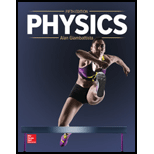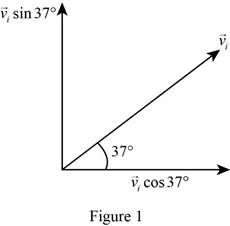
Concept explainers
(a)
The maximum height above the ground reached by the cannonball.
(a)
Answer to Problem 61P
The maximum height above the ground reached by the cannonball is
Explanation of Solution
Take the

Write the equation of motion.
Here,
When the cannon ball reaches maximum height, its velocity will be zero.
Write the equation for
Here,
The acceleration of the ball will be the negative of acceleration due to gravity.
Write the equation for
Here,
Put equations (II) to (V) in equation (I) and rewrite it for
Conclusion:
Given that the initial height of the cannonball is
The value of acceleration due to gravity is
Substitute
Therefore, the maximum height above the ground reached by the cannonball is
(b)
The horizontal distance from the release point at which the cannonball will land if it makes it over the castle walls and lands back down on the ground.
(b)
Answer to Problem 61P
The horizontal distance from the release point at which the cannonball will land if it makes it over the castle walls and lands back down on the ground is
Explanation of Solution
Write the equation of motion in
Here,
Write the equation for the horizontal distance at which the cannonball lands.
Here,
Rewrite the above equation for
Refer to figure 1 and write the equation for
Put equation (IX) in equation (VIII).
Put equations (III), (IV) and (X) in equation (VII).
Solve the above quadratic formula in
Conclusion:
When the cannonball reaches the ground the value of
Substitute
The catapult does not fire backward. This means
Therefore, the horizontal distance from the release point at which the cannonball will land if it makes it over the castle walls and lands back down on the ground is
(c)
The
(c)
Answer to Problem 61P
The
Explanation of Solution
The
Here,
Put equation (IX) in the above equation.
Rewrite equation (I) for
Put equations (III) and (IV) in the above equation and rewrite it for
Conclusion:
Substitute
Substitute
The negative sign indicates the velocity is downward.
Therefore, the
Want to see more full solutions like this?
Chapter 3 Solutions
Physics
- In the figure, two boxes, each of mass 35 kg, are at rest and connected as shown. The coefficient of kinetic friction between the inclined surface and the box is 0.38. Find the speed of the boxes just after they have moved 5.5 m. Please do on paper and show all formulas and work done to get final answer This is a review problem , I just keep getting the wrong thing from what the textbook says , so i would like to see the work donearrow_forwardA 64.0-kg skier starting from rest travels 200.0 m down a hill that has a 30.0° slope and a uniform surface. When the skier reaches the bottom of the hill, her speed is 30.0 m/s. How much work is done by friction as the skier comes down the hill? Please do on paper and show all the equations and work done to get to the final answer.arrow_forwardA 550-kg car moving at 18.5 m/s hits from behind a 560-kg car moving at 11.8 m/s in the same direction. If the new speed of the heavier car is 16.0 m/s, what is the speed of the lighter car after the collision, assuming that any unbalanced forces on the system are negligibly small? Please do on paper and show all equations and work done to get to the final answer. Along with any helpful diagrams if needed. These are a part of my review questions in the book but i keep getting different answers from what the book says, it is not a graded assignment***arrow_forward
- A 150kg piano rolls down a 30° incline. A man tries to keep it from accelerating, and manages to keep its acceleration to 1.4 m/s^2 . If the piano rolls 8 m, what is the net work, in joules, done on it by all the forces acting on it? Please do it on paper and show all formulas and work used to get the answerarrow_forwardThe rectangular loop of wire shown in the figure (Figure 1) has a mass of 0.18 g per centimeter of length and is pivoted about side ab on a frictionless axis. The current in the wire is 8.5 A in the direction shown. Find the magnitude of the magnetic field parallel to the y-axis that will cause the loop to swing up until its plane makes an angle of 30.0 ∘ with the yz-plane. The answer is .028 T, I just need help understanding how to do it. Please show all steps.arrow_forwardA ray of light from an object you want to look at strikes a mirror so that the light ray makes a 32 degree angle relative to the normal line (a line perpendicular to the surface of the mirror at the point where the ray strikes the mirror). If you want to see the object in the mirror, what angle does your line of sight need to make relative to the normal line? Give your answer as the number of degrees.arrow_forward
- Suppose you have a converging lens with a focal length of 65 cm. You hold this lens 120 cm away from a candle. How far behind the lens should you place a notecard if you want to form a clear image of the candle, on the card? Give your answer as the number of centimeters.arrow_forwardSuppose you have a diverging lens with a focal length of - 25 cm. You look through this lens at a sleeping squirrel, and notice that it forms a virtual image of the squirrel with di = - 18 cm. How far away from the lens is the squirrel? Give your answer as the number of centimeters (a positive number).arrow_forwardDiamond has an index of refraction of about 2.4. Suppose you cut a diamond so it has a flat surface, and shine a laser pointer beam so that it makes a 27 degree angle with respect to the normal line to that surface. What angle will the laser beam make with respect to the normal after it passes through the air-diamond boundary and is inside the diamond? Give your answer as the number of degrees.arrow_forward
- Find current of each line of D,E, and F. Where V1 is 9V, V2 is 7V, R1 is 989 , R2 is 2160, R3 is 4630 , R4 is 5530, R5 is 6720, and E is 16V. Please explain all steps. Thank youarrow_forwardYou are tasked with designing a parallel-plate capacitor using two square metal plates, eachwith an area of 0.5 m², separated by a 0.1 mm thick layer of air. However, to increase the capacitance,you decide to insert a dielectric material with a dielectric constant κ = 3.0 between the plates. Describewhat happens (and why) to the E field between the plates when the dielectric is added in place of theair.arrow_forwardCalculate the work required to assemble a uniform charge Q on a thin spherical shell of radiusR. Start with no charge and add infinitesimal charges dq until the total charge reaches Q, assuming thecharge is always evenly distributed over the shell’s surface. Show all steps.arrow_forward
 College PhysicsPhysicsISBN:9781305952300Author:Raymond A. Serway, Chris VuillePublisher:Cengage Learning
College PhysicsPhysicsISBN:9781305952300Author:Raymond A. Serway, Chris VuillePublisher:Cengage Learning University Physics (14th Edition)PhysicsISBN:9780133969290Author:Hugh D. Young, Roger A. FreedmanPublisher:PEARSON
University Physics (14th Edition)PhysicsISBN:9780133969290Author:Hugh D. Young, Roger A. FreedmanPublisher:PEARSON Introduction To Quantum MechanicsPhysicsISBN:9781107189638Author:Griffiths, David J., Schroeter, Darrell F.Publisher:Cambridge University Press
Introduction To Quantum MechanicsPhysicsISBN:9781107189638Author:Griffiths, David J., Schroeter, Darrell F.Publisher:Cambridge University Press Physics for Scientists and EngineersPhysicsISBN:9781337553278Author:Raymond A. Serway, John W. JewettPublisher:Cengage Learning
Physics for Scientists and EngineersPhysicsISBN:9781337553278Author:Raymond A. Serway, John W. JewettPublisher:Cengage Learning Lecture- Tutorials for Introductory AstronomyPhysicsISBN:9780321820464Author:Edward E. Prather, Tim P. Slater, Jeff P. Adams, Gina BrissendenPublisher:Addison-Wesley
Lecture- Tutorials for Introductory AstronomyPhysicsISBN:9780321820464Author:Edward E. Prather, Tim P. Slater, Jeff P. Adams, Gina BrissendenPublisher:Addison-Wesley College Physics: A Strategic Approach (4th Editio...PhysicsISBN:9780134609034Author:Randall D. Knight (Professor Emeritus), Brian Jones, Stuart FieldPublisher:PEARSON
College Physics: A Strategic Approach (4th Editio...PhysicsISBN:9780134609034Author:Randall D. Knight (Professor Emeritus), Brian Jones, Stuart FieldPublisher:PEARSON





